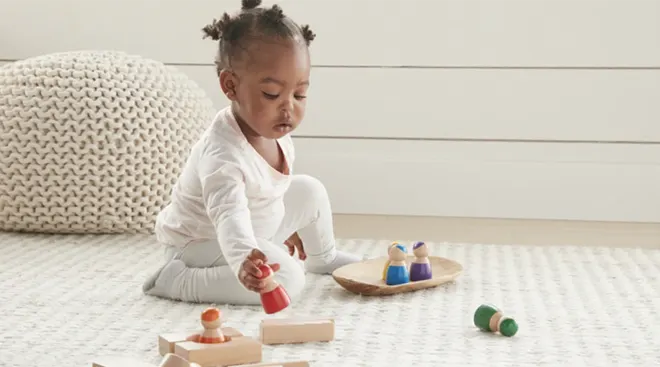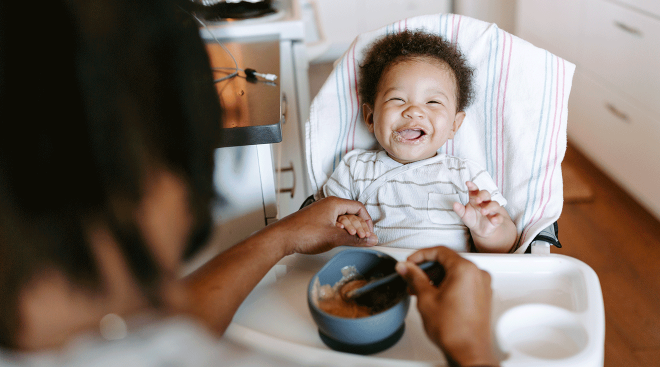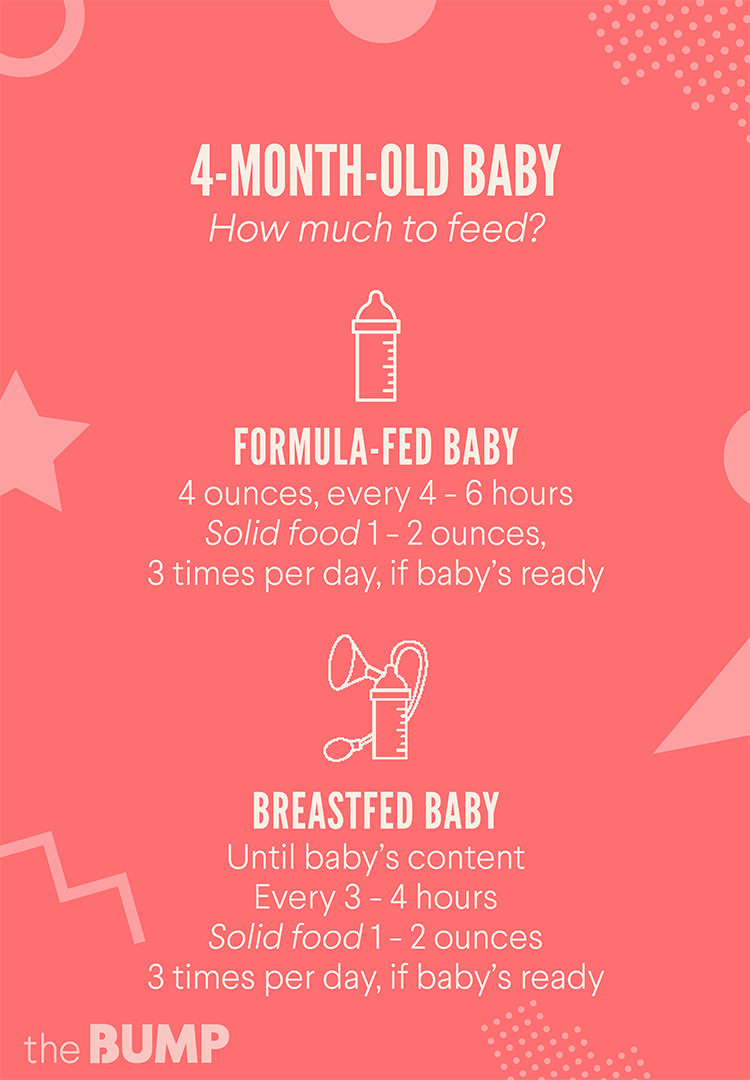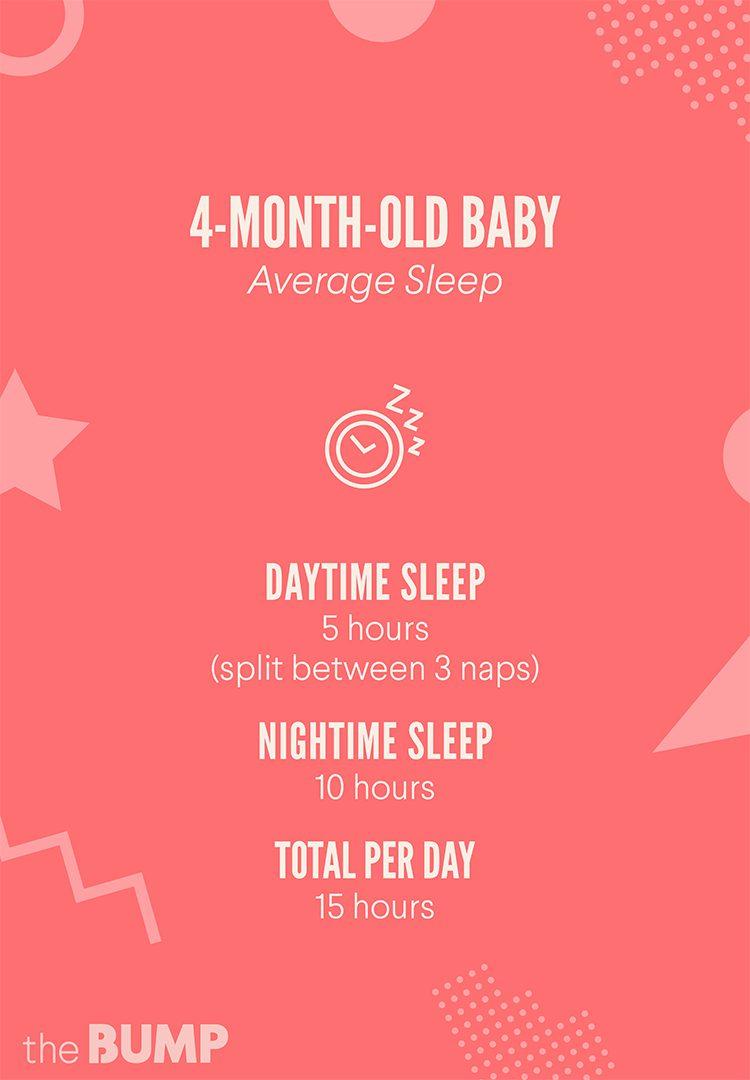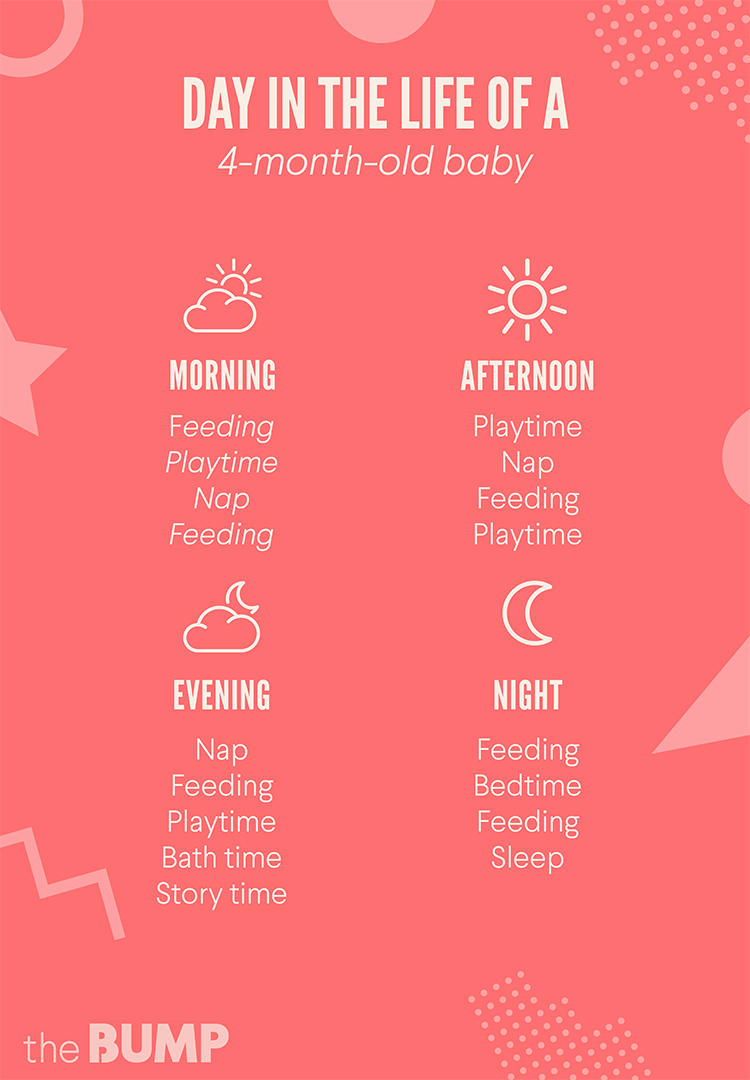4-Month-Old Baby

4-Month-Old Baby
Life for a 4-month-old baby is all about playtime! Baby’s laughing and reaching—and doing tons of gnawing. While you two play on the floor, baby is probably showing off some newfound athletic abilities, such as rolling and pushing up. Not able to carve out time to go to the gym? Your kiddo is showing you how it's done (and they have the growth to show for it)! Use baby as your own little motivator and personal-trainer-in-the-making. Why not get down on the floor and do some exercises of your own?
As baby gets older by the day, you’ll notice they’re hitting their fair share of 4-month-old baby milestones. This is the stage when your child will start showing more interest in interactive play, and there’s a good chance they’ll start teething soon too. While you’re quickly becoming a rockstar in your role as a caregiver, you probably still have some new questions: Can I give my 4-month old water? When does baby start eating real food? Is sleep regression inevitable?
Feeling a bit overwhelmed? We’ve got the info you need to help keep your 4-month-old baby happy and healthy. From feeding schedules to sleep routines, this guide will help you ensure you and your little are right on track.
Your four-month-old continues to grow and learn new skills. It’s an exciting time, and you’ve got a front-row seat for all the 4-month-old moments and milestones.
4-month-old baby weight and length
How much should a 4-month-old baby weigh and measure? The average weight for a 4-month-old baby is 13.8 pounds for girls and 15 pounds for boys; the average length (aka height) is 24.2 inches for girls and 24.8 inches for boys.
Of course that doesn’t mean your 4-month-old should weigh and measure exactly that. Remember: Healthy babies tend to follow a natural growth curve, staying within the same percentile as they grow older, and it’s the growth itself that’s an indicator of healthy development—not the actual percentile.
Baby probably has gained an extra 1 to 1.25 pounds in the past month.
4-month-old’s five senses
Your 4-month-old baby is learning about the world through all their senses. Baby’s bringing their hands to their mouth and feeling objects with their mouth too.
They’re listening to you talk and imitating you; you’re probably having little “chats.” Play peekaboo and make funny faces to get baby giggling. Baby is beginning to develop depth perception.
4-month-old baby milestones
“What should my 4-month-old be doing?” you ask? Here’s a peek:
- The 4-month-old baby milestones are exciting for you and baby. At this age, they may start holding their head up without support and grasping toys on their own. Baby is getting stronger every day, and you’ll start noticing some serious progress.
- Baby may be able to roll from their stomach to their back and push up to their elbows.
- Baby loves to reach for toys! Plastic keys, teething rings and soft books are good choices at this age.
- For a 4-month-old, teething may have begun, which means you’re probably finding drool on everything baby touches!
Having a baby seems like a never-ending search for answers to health questions. Here are some common things parents ask:
- Can a 4-month-old be teething? (Yes!)
- How often should a 4-month-old poop?
- My 4-month-old is constipated. What should I do when my 4-month-old is not pooping?
- My 4-month-old has diarrhea. What should I do?
- My 4-month-old is spitting up a lot. What should I do?
- My 4-month-old has a cough. What should I do?
- My 4-month-old is vomiting. What should I do?
- My 4-month-old has a fever. What should I do? (For a 4-month-old, a fever after shots is normal. Ask the doctor about giving baby OTC fever meds.)
- What should my 4-month-old’s heart rate be? (FYI, 100 to 150 beats per minute is the normal range for infants.)
Just when it feels like you’ve gotten into a rhythm with feeding your 4-month-old, things might switch up a bit. Change is the name of the game in this whole parenting gig!
What can a 4-month-old eat?
You should continue to feed baby breast milk or formula (or both, as some supplementing moms do). But what you might really want to know is: Can I give my 4-month-old baby food? The answer is…maybe.
Different babies are ready for solid foods at different ages. Talk it over with baby’s doctor. Before you chat, look out for these signs of readiness:
- Baby holds their head up high and for long periods of time.
- Baby can sit upright (while propped) in a high chair.
- Baby’s interested in food and opens their mouth to try to taste it.
- Baby has lost the extrusion reflex and will no longer push everything out with their tongue
- Baby lets you know when they are full by pushing the bottle or breast away
- Baby is staring you down and trying to grab the food you are eating
Once you decide to start, you’ll have to choose a first food for baby. Avocado, bananas, sweet potatoes and single-grain baby cereal are all popular choices. Wondering how much cereal (or fruit or veggie) for a 4-month-old is appropriate? You’ll have to start slow. Just one or two ounces at a meal is plenty; if baby doesn’t seem interested in finishing, don’t force it. Introduce a new food once every few days, looking out for signs of a food allergy.
How much does a 4-month-old eat?
- Bottle feeding. How much formula for a 4-month-old? Typically four ounces about four to six times a day.
- Breastfeeding. How often should a 4-month-old nurse? Feedings are still typically about every three or four hours, but each breastfed baby may be slightly different. What’s important is that baby seems content, your boobs seem to have been emptied (they’re soft) and baby’s gaining weight healthily.
- Pumping. If you’re pumping breast milk, you’re probably wondering how many ounces of breast milk for a 4-month-old is enough. Baby needs about 25 ounces of breast milk per day. So you’ll need to divide that by how many feedings baby typically has. So if you feed baby about eight times per day, they should get about 3 to 4 ounces of breast milk at each feeding.
To double-check that baby’s getting enough breast milk, you can monitor their diapers. How many wet diapers for a four-month-old baby is healthy? About four or five very wet ones per day.
Can I give my 4-month-old water?
It’s important to remember that babies get their hydration from their breast milk or formula. Most experts recommend waiting to give baby water until they’ve reached the six-month mark or once they begin eating solid foods. Talk to your pediatrician if you have any questions about introducing water.
4-month-old feeding schedule
Four-month-old feeding schedules can look a bit different for every family, but if you’re looking for a good example, we’ve got you covered. Here’s a a sample 4-month-old feeding schedule for breastfeeding or bottle-feeding:
Four-month-old babies tend to throw us for a loop when it comes to sleep, switching up how long they’re sleeping and how much they wake up at night; and they may even start to roll over in their crib. Here’s how to handle some common sleep dilemmas at four months.
How much should a 4-month-old sleep?
Four-month-olds typically sleep about 12 to 16 hours a day, split between a longer nighttime stretch and two daytime naps.
How long should a 4-month-old sleep?
Four-month-old babies might wake up during the night—there’s no need to stress, as this is developmentally normal. It’s common for a 4-month-old nap schedule to consist of a morning nap and an afternoon nap that are longer, along with a quick evening nap. Some babies at this age just take two longer naps.
4-month-old sleep schedule
Four-month-old babies need lots of sleep. Here’s a typical schedule that may work for you and your child:
My 4-month-old won’t sleep! Why?
At four months, some parents report that their good sleeper suddenly isn’t such a good sleeper. Or maybe their 4-month-old wakes up screaming more often in the middle of the night than they used to do.
There’s a term for this: 4-month-old sleep regression. Babies this age don’t sleep as deeply as they used to; plus, their brains are more active, making them more alert. A soothing sleep routine can help baby get back to snoozing more soundly. So can getting baby used to falling asleep on their own in the crib, rather than in your arms (we know—easier said than done!).
Can I sleep train my 4-month-old?
This is a personal choice, but some experts say you can start sleep training around this time. Looking for signs that baby might be ready for sleep training? If they’ve gotten into a regular sleep routine and dropped most of their middle-of-the-night feedings, it’s probably a good time. Read more about how to sleep train baby to see if it’s right for your family.
Is it okay for baby to sleep on their stomach?
You should be putting baby down in the crib on their back, to reduce the risk of Sudden Infant Death Syndrome (SIDS). That said, if you check the monitor or walk in baby’s room and find your 4-month-old sleeping on their stomach, you’ve got a roller on your hands! Letting baby sleep on their stomach can be a scary notion after you’ve been taking all of these precautions the whole time. But it’s safe to let your little one sleep on their tummy if they got there on their own, if they’re strong enough to lift their head and roll completely over you can feel reassured. Another safety tip: You should stop swaddling baby, if you haven’t already, once they start rolling over.
Four-month-old babies need plenty of downtime, but they like to be kept busy too! Now that you’ve got an active, playful baby on your hands, you’re probably looking for more things to do with your 4-month-old. Check out this list of baby activities that will give you an idea of 4-month-old activities, as well as things to do with baby as they grow.
A 4-month-old’s daily schedule might look something like this:
Four-month-old babies love to be engaged and entertained. So how do you play with a 4-month-old? Here are some ways to keep things fresh and fun.
- Now is a great time to begin introducing nursery rhymes. Sing to baby and encourage them to coo and babble along with you.
- There’s a reason the game “peekaboo” is so popular. As a 4-month old baby matures, they’ll love engaging with you and seeing your silly faces. At this point, they’re probably trying to mimic some of your funny mugs too!
- Try introducing some new colorful toys that show cause and effect. They may start reaching for and grasping toys on their own; solo playtime is just starting to get fun!
- Take baby to their four-month-old checkup.
- Check baby’s vaccine schedule; the American Academy of Pediatrics recommends a second dose of the pneumococcal (PCV13), DTaP, Hib, poliovirus and Rotavirus immunizations at the four-month visit. Talk to your doctor if you’re concerned about 4-month-old shot side effects.
- Schedule baby’s six-month checkup.
- Decide, along with your pediatrician, whether or not to start baby on solids this month.
- Regularly check the floor for small objects that are choking hazards, since baby’s putting everything in their mouth!
- Take baby’s 4-month-old baby milestone photo.
- Tummy time remains important at this age.
Four-month-old babies have emerging personalities of their own. They may begin revealing some likes and dislikes through sounds and facial expressions. What’s more, you might hear the absolutely delightful sound of baby laughter. Enjoy this wondrous phase (sleep regression and all!); your little one is growing up quickly!
Please note: The Bump and the materials and information it contains are not intended to, and do not constitute, medical or other health advice or diagnosis and should not be used as such. You should always consult with a qualified physician or health professional about your specific circumstances.
Navigate forward to interact with the calendar and select a date. Press the question mark key to get the keyboard shortcuts for changing dates.






































